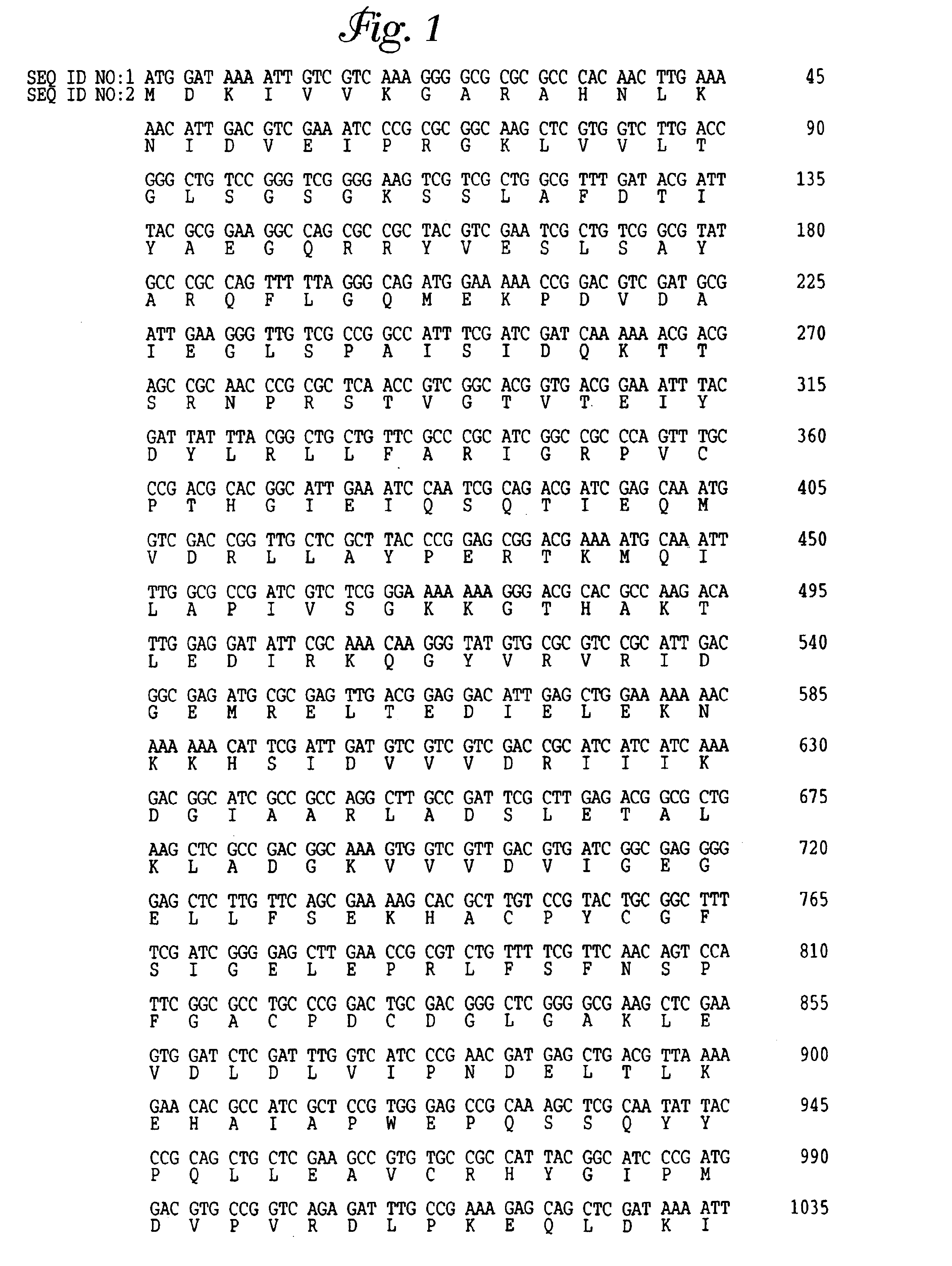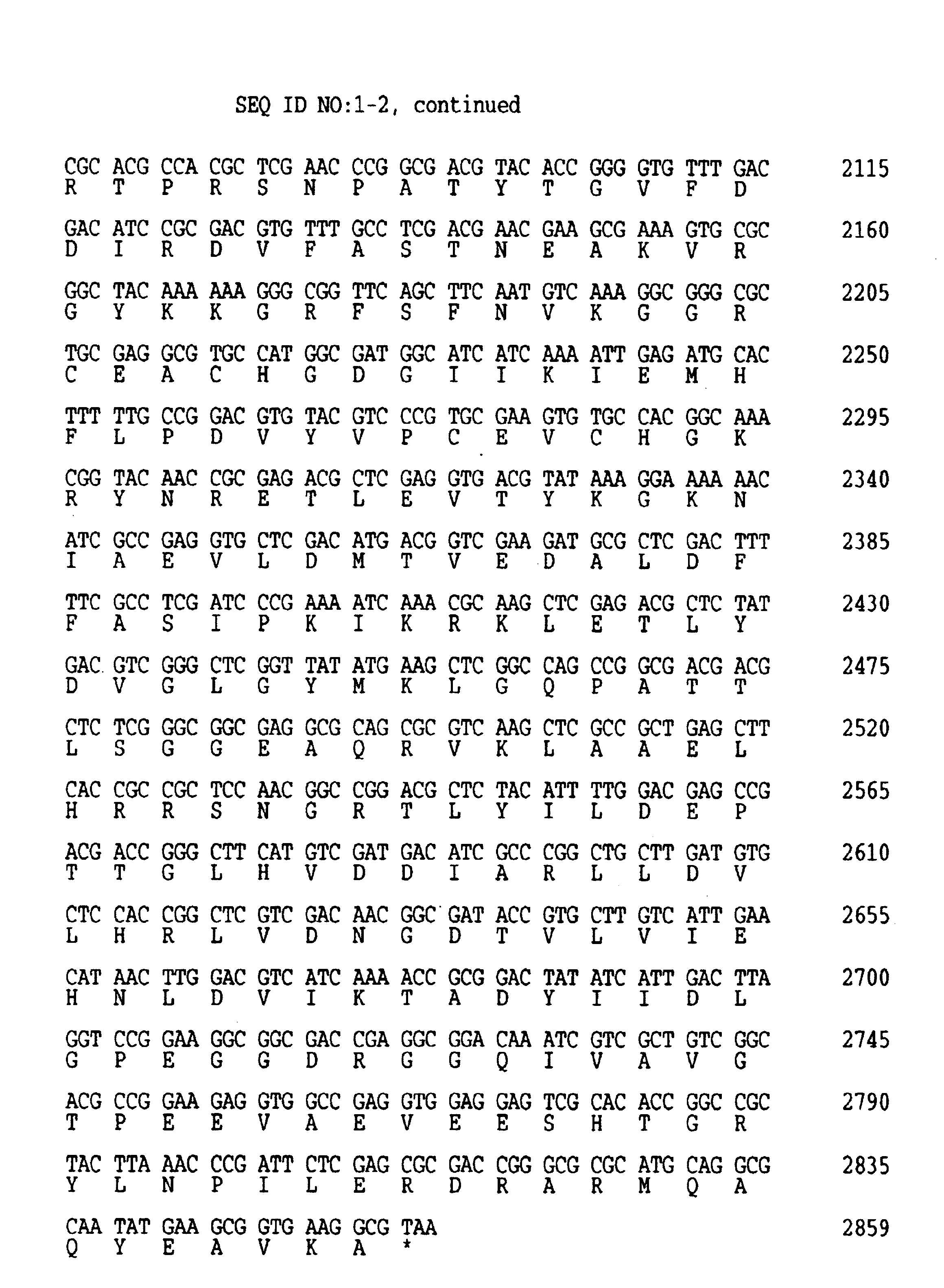Thermostable UvrA and UvrB polypeptides and methods of use
- Summary
- Abstract
- Description
- Claims
- Application Information
AI Technical Summary
Benefits of technology
Problems solved by technology
Method used
Image
Examples
example 1
Cloning and Expression of the uvrA Gene from Thermophilic Eubacterium, Bacillus caldotenax
Enzymes and Chemicals.
[0101]The DNA modification enzymes T4 DNA ligase and calf intestinal phosphatase (CIP) were obtained from Promega (Madison, Wis.). Restriction endonucleases were obtained from Promega, Gibco (now Invitrogen, Carlsbad, Calif.) and New England Biolabs (NEB; Beverly, Mass.); Pyrococcus furiosus (Pfu) DNA polymerase was obtained from Stratagene (La Jolla, Calif.). Isopropyl-β-D-thiogalactopyranoside (IPTG) was from Sigma (St. Louis, Mo.). ATP was from Roche (Indianapolis, Ind.), and γ-[32P]-ATP was purchased from Dupont (Wilmington, Del.). All other chemicals, if not specified otherwise, were obtained from Fisher Scientific (Pittsburgh, Pa.).
[0102]The T7 IMPACT System (New England BioLabs; Beverly, Mass.) was used for protein purification. IMPACT (Intein Mediated Purification with an Affinity Chitin-binding Tag) utilizes the inducible cleavage activity of engineered protein s...
example 2
Cloning and Expression of the B. caldotenax uvrB Gene
[0159]During sequencing of approximately 4.4 kb B. caldotenax genomic DNA fragment containing the Bca uvrA gene and conferring the UVR 4NQOR phenotype of the E. coli UNC1158 (UvrA−) host cells described in Example 1 it was discovered that the insert also contained 370 base pairs of the 3′ terminus of the uvrB gene. This finding suggested that B. caldotenax might have an organization of uvrA and uvrB genes similar to that of B. subtilis in which both genes constitute a single operon with the uvrB gene located upstream and with only an 8 bp-gap separating the two genes.
[0160]Utilizing the sequence of an adjacent gene (Bca uvrA), the inverse PCR technique was employed for the cloning of Bca uvrB gene. Inverse PCR allows in vitro amplification of a DNA flanking a region of known sequence (Ochman et al., (1988) Genetics 120, 621-3; Silver and Keerikatte (1989) J. Virol. 63, 1924-8; Triglia et al., (1988) Nucleic Acids Res 16, 8186). B....
example 3
Crystal Structure of UvrB
[0166]As a first step in understanding the structural details of NER, the three-dimensional structure of UvrB from the thermophilic organism Bacillus caldotenax at 2.6 Å resolution has been determined (Theis et al., EMBO J. 18, 6899-6907 (1999)). These results indicate that UvrB can be divided into four domains, termed 1a, 1b, 2 and 3, with the ATP binding site being located between domains 1a and 3. Two of the domains of UvrB (1a and 3) are structurally related to helicases belonging to superfamilies I and II, and all residues implicated in coupling ATP hydrolysis to strand translocation in these helicases are present in UvrB as well. The UvrB structure is thus evidence that UvrB functions as a helicase adapted to the unique requirements of DNA repair. One of these requirements is the ability to form a tight pre-incision complex with damaged DNA. Based on the crystal structure we propose that in the pre-incision complex UvrB uses a padlock-like binding mode...
PUM
| Property | Measurement | Unit |
|---|---|---|
| Temperature | aaaaa | aaaaa |
| Temperature | aaaaa | aaaaa |
| Temperature | aaaaa | aaaaa |
Abstract
Description
Claims
Application Information
 Login to View More
Login to View More - R&D
- Intellectual Property
- Life Sciences
- Materials
- Tech Scout
- Unparalleled Data Quality
- Higher Quality Content
- 60% Fewer Hallucinations
Browse by: Latest US Patents, China's latest patents, Technical Efficacy Thesaurus, Application Domain, Technology Topic, Popular Technical Reports.
© 2025 PatSnap. All rights reserved.Legal|Privacy policy|Modern Slavery Act Transparency Statement|Sitemap|About US| Contact US: help@patsnap.com



